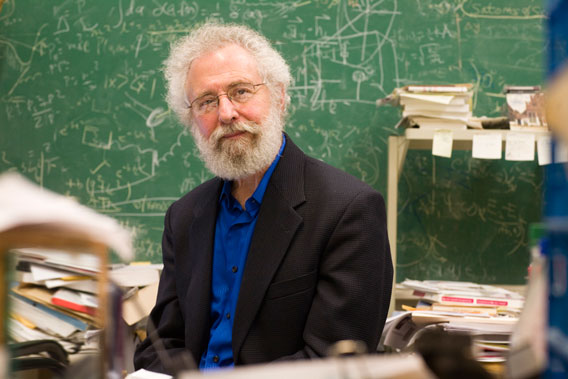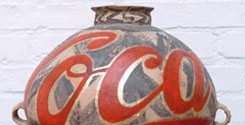Spin Cycle
For physicist Gary Goldstein, twisting and turning subatomic particles are at the heart of his effort to answer the basic question: what makes all matter in the universe tick?
By Taylor McNeil
In Gary Goldstein’s world, spin is the center of everything. No, he’s not a political campaign consultant or public relations guru: the spin he’s interested in is far more fundamental. A theoretical particle physicist, Goldstein has spent the past 40 years—almost all of them at Tufts—working to understand the basic forces that make up our world. It is work, he said at a recent campus talk, that makes one “look in awe at the orderliness of nature.”

“The more we know, the more we find surprises,” Gary Goldstein says of his work in high energy physics. Photo: Melody Ko
Goldstein spends his days theorizing about the elusive particles that are the building blocks of everything in the universe, and has had a hand in several major advances in the field, such as helping find the missing “top” quark. He pumps out four or five scientific papers each year for prestigious journals, but it’s not the imperative to publish that drives him: it’s a never-ending curiosity about what makes the natural world tick.
Atoms, of course, are made up of electrons, protons and neutrons, but the picture gets murkier once you delve beyond those basic facts. While electrons are apparently indivisible, neutrons and protons are made of particles called quarks. “They are like tops, constantly spinning,” says Goldstein, who also likens them to “billiard balls bouncing around.” Deciphering the relationship between the spins of the many quarks and the spins of protons and neutrons is “a difficult problem,” he says with a certain amount of understatement.
Goldstein’s work—and that of theoretical physicists like him—is an effort to better understand the fundamental laws of particle physics, and how they all fit into what’s known as the Standard Model, a “theory of everything” that sometimes raises more questions than it answers. “That’s one aspect of the science that really keeps us all going—the fact that there are always more questions,” Goldstein says. “The more we know, the more we find surprises, and that forces us to refine or change our theoretical ideas, and then in turn we find other surprises.”
Along with a colleague at the University of Oregon, two decades ago he proposed a novel way of thinking about particle spin. Some particles, they suggested, spin perpendicular, or transverse, to each other. “We essentially invented this idea that has to do with how the spins of these objects are aligned perpendicular to their motion,” he says. “We discovered that some data on collisions of protons and neutrons was easier to interpret if we imagined that the spins were transverse.”
The transverse spins were confirmed in initial experimental results and led to the founding of a new area of particle physics called transversity. “I’m happy to say I’m one of the originators of this field,” says Goldstein, a professor of physics in the School of Arts and Sciences. Experiments designed to further probe the transverse effect are currently running or have been proposed at the Thomas Jefferson National Accelerator Facility in Newport News, Va., and at Brookhaven National Laboratory in New York.
Smashing Protons
Goldstein doesn’t do the experimental work, but that doesn’t mean he’s not interested in getting his hands dirty, so to speak. He regularly works with experimental physicists around the world, who blast electrons at protons and neutrons at very high energies, gathering data on the scattering of particles. “Among theoretical physicists, I am in the category called phenomenologist,” he says. “I get especially excited by experimental data and try to understand it, and predict more data.”
Over the last decade, as experimenters probed the spin structure of the neutrons and protons, “they often found surprising results that we theorists try to understand,” Goldstein says. Some of that spin is controlled by a particle called a gluon, “which gets its name from what was called nuclear glue long ago, back in the thirties and forties, when people were speculating what held the nucleus together.” Carrying the force that keeps protons, which normally repel each other, together in a very tiny space, gluons are a particular focus of Goldstein’s research.
Just as Goldstein feels most at home in that border region between theory and experiment, he also straddles what he considers the two key questions in physics: how and why. “The how questions have to do with what the patterns are, how things repeat themselves, what you can observe of some underlying principle or law,” he says. “The why questions ask what the mechanism is that gave rise to those patterns.
“I have to see the patterns, but then I have to see how to explain them. It’s that interplay between the two that I find most interesting,” he says. “Without the phenomena, to actually touch and see, in a sense, what’s happening, the why questions aren’t so interesting.”
It was that approach that helped him develop, with Richard Dalitz of Oxford University, a method for determining the exact properties of the so-called “top” quark. That technique contributed to the discovery in 1995 of what researchers think is the last undiscovered quark at Fermi National Accelerator Laboratory.
Science for the Rest of Us
Goldstein does more than theoretical particle physics, of course. He’s been teaching physics majors at Tufts for four decades, and also periodically teaches the Physics for Humanists course, as he is this semester, about modern physics and how it affects our world. The course is “an introduction to relativity and quantum physics, with connection to the development of things like transistors and computers and nuclear weapons,” he says.
He’s also active in seeking to invigorate elementary school science education as a member of the Fulcrum Institute at Tufts, and the Cambridge-based TERC, both of which promote better science education in the schools. A current TERC project, for example, seeks to instill in teachers “what science is and how children from different cultural backgrounds bring different perspectives on what it means to learn science,” he says. “It’s very interesting work, and gives me a very different perspective than most scientists and science educators have.”
He’s not shy about expressing his political views, either. That’s not surprising for someone who, as a graduate student at the University of Chicago in 1968, was getting tear-gassed while demonstrating outside the Democratic National Convention. He’s now a board member of Massachusetts Peace Action Education Fund and frequently speaks out against nuclear weapons proliferation. One night in January, for example, he was at LaSalle College, speaking about the danger of nuclear weapons to a crowd of about 60, most of them retirees.
His own work, he is quick to point out, is very different from the physics research that led to the development of nuclear weapons. “It gives us insight into how the world works, but doesn’t give us clues about how to change the way the world works. It’s not like nuclear physics in the 1940s. Which,” he adds with a laugh, “is fine.”
Taylor McNeil can be reached at taylor.mcneil@tufts.edu.


